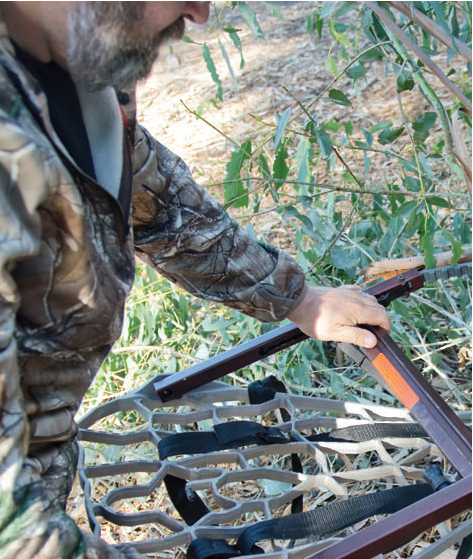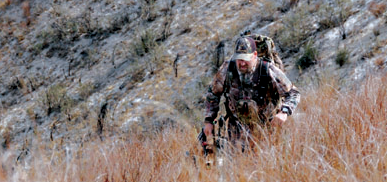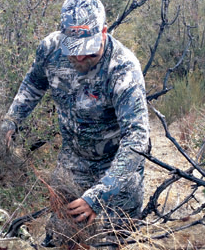The Socal Bowhunter Following The Deer Rules
Editor’s note: The author actively promotes tree-stand safety and wears a safety harness. For the purpose of shooting these photographs, he did not have it on as he was only 4 feet off the ground and wanted to emphasize the size of the stand. Please be sure to wear your safety harness each and every time to use a tree stand.
LONG BEACH–Ask any bowhunter what the best way to hunt deer is and you’ll get a variety of different answers. The same goes for bear and feral pigs. For me, there are three ways to successfully hunt big game in California: spot and stalk; hunting from a blind; and hunting from a tree stand. Spot and stalk is preferred, and many wouldn’t even consider the last two, but depending on where you are hunting and the animals you are after, hey can be utilized
quite well. You will have to do some research to figure out the best
method for you and your area, but after you have done your homework you can increase your chances of filling that
tag. Let’s face it – in the modern hunting age, new gear is created each year to give us an edge, to be more efficient hunters. The new gear doesn’t always work everywhere and isn’t always the easiest to get used to. I don’t always think easier is the best approach to some things either. Take hunting in California for example. If I had to describe hunting in California in a single word, it would be tough, and I like the challenge. Add to the mix the overwhelming
number of hunting blinds and tree stands on the market and frustration can quickly set in, but hopefully I can help with that.
SPOT AND STALK
In my opinion, spot and stalk hunting is the most effective method to hunt deer and pigs in Southern California. It allows you the freedom to move about and go after them instead of waiting for them to come to you, which honestly might never happen.
Stalking takes practice, and I am going to help you properly plan for a successful one. Here’s the scenario: you have glassed up a buck in the morning hours and he is heading to his bedding area. You have two choices: try to cut him off or you can watch him bed down and then put on a stalk. My advice is to stay put and watch him bed down. You do not want to alarm him– or any other deer that might be watching. If he’s bedded he’ll be laying down a certain way so you can plan your approach. If the temperature is rising, he is likely to stay put for a couple hours.Approach him from downwind, otherwise he will wind you and bolt. That’s the worst way to blow a stalk and it will leave an empty feeling in the pit of your stomach. Play the wind, be patient, and slowly get in close. Be sure you are
coming from above him and not below him. There’s a very good chance he will spot you if you make a lowland approach. Take care where you step, as any extra noise will likely set off an alarm and the deer will scatter. To avoid this, you could take your boots off. This
allows you to walk in your socks, very quietly as you approach. You will feel any branches under your feet before putting your full weight down. Now, if you are in rattlesnake country, use caution.
You can still put on a great stalk with your boots on and a stalk is not
worth a trip to the hospital. I have learned that you usually have more time on a stalk than you think. Your mind will begin to play tricks on you, but stay calm and focused. Be patient and slowly creep in toward the bedded animal. When you are within range only you can be the judge of when it is safe to draw. You have to be on the lookout for other sets of eyes peering at you, too. Draw, set your pin
and make the shot count! If you have kids, you can start prepping
them early and teach them some stalking techniques. My 5-year-old
daughter loves practicing her spot-and stalk technique on the herons and egrets at our local park. It’s wonderful to watch and my pride swells when I watch her get close! Hopefully she will be scouting the forest with me one day in hopes of filling her own big-game tag.

his climbing tree stand during
a recent scouting trip to
Southern California in advance
of deer season, which
starts in many zones this
month. (ALBERT QUACKENBUSH)
TREE STANDS
As an old whitetail hunter from up state NewYork, I used to hunt primarily out of a tree stand and the need to spot and stalk wasn’t a priority. I took it for granted that I always had private land to hunt and could leave a tree stand up all year. Now that I live in California, I focus on hunting public land, off of the main trails, and that is where I concentrate my preseason scouting. If the area has game trails and I have patterned the animals to a degree through use of trail cameras, I will entertain the thought of using a tree stand. With that

and traversing steep terrain. (ALBERT QUACKENBUSH)
being said, it won’t be your typical stationary tree stand left mounted to the tree. The main reasons are that it is public land and it is there for everyone to use. Leaving a stand up for a long period of time on public land doesn’t feel right tome. Also, a stationary tree stand ultimately limits you to hunting a certain area.
Unless you have multiple stands up, you are stuck hunting one spot. The other issue with them being on public land is, sadly, that they run the risk of being stolen. For those reasons I use a climbing tree stand. I utilize a climber for many reasons, the first being that I paid good money for the stand and don’t want it growing legs and walking out of the woods. Also, when I hunt a wooded area and I need to get high in a tree, a climber offers me the freedom to go as high as I want to,without the limitations that ladders have. Plus, when I use a climber, I can be more mobile and can move stand locations much faster than if I were using a stationary stand.
Which stand would I recommend for California hunters? I have used a few different climbers from Summit, but they weigh a bit more than I like for the amount of hiking I do. The one I think works best for hunters having to hike in a long way is the Lone Wolf Assault
climbing tree stand. It weighs in less than 15 pounds and is very easy to carry using the backpack straps. It is what I would call a minimalist climber. It is easy to pack in, but does take some practice getting used to how it functions. I had to watch the online how-to videos a couple times and practice with it a few times before I mastered it. The Assault has a very small seat,which is the platform used to push off of as you are climbing, and requires a decent amount of upper body strength. Take note – don’t use a climber in a palmtree. They are prevalent in Southern California and will be tempting to
climb, but the descent is brutal.Another lesson I learned when using a climber is that wearing a binocular chest harness gets in the way. Californians love having their optics close at hand and many of us utilize chest harnesses. Leave it attached to your pack to be hauled up after you have made your ascent. One of the differences with this
climber compared to others is that instead of cables to go around the tree it uses traction belts. These belts are ribbed and grip the bark well. The small platform also has a built-in bow holder that works rather well, just in case you forget to bring any hooks to screw into the tree.
BLINDS
Ground blinds can be used in a variety of situations, but I truly only use them if I have to. The most commonly used ground blinds are pop-up blinds. They are great for keeping you out of the elements and keeping your scent reduced. I use a Primos pop-up ground blind in Predator Camo when I turkey hunt or if I am hunting feral pigs, but I rarely use one for bear or deer. The Primos blind is nice because it goes up very quickly. It is beneficial because your movement is hidden for the most part and the animals won’t spot
you. The downsides are that they are rather bulky and they can also be incredibly warm inside as California temperatures rise. A pop-up blind can also be extremely limiting when it comes to archery shots. Regardless, they are an effective tool for hunting feral pigs and turkey. Rolled gound blinds are lightweight, convenient and easily portable, but you are only minimally covered. As a bowhunter, these work very well and allow you 360 degrees of motion. They are far less expensive than a pop-up ground blind and easier to set up. These work very well for uneven terrain and breaking up your pattern. I have utilized these far more because of their ease of use and the uneven terrain I hunt. A rolled ground blind also allows you set up quickly and pick up and move to a new location quickly if you
need to.Making your own is a rewarding experience. Then there is the blind you make when you get to the woods by using branches and material already found out there.While this can work well for
many, I tend to shy away from building my own for a few reasons. First, I don’t like to trim too much off the trees on public land in the areas I hunt. The main reason is that there is poison oak all over down here and would hate to get it. Sure, I wear gloves, but all it takes is one little mistake and BAM! Good luck avoiding getting it. But using what nature offers is the best material to creating your own camouflage barrier between you and the animal. If the area is free of poison oak and there are dead branches or bushes around, I can combine them to provide a minimalist blind that gives me some cover. The major benefit to making your own is that you don’t have to pack anything extra in and you can leave it there when you hike out. After years of hunting in California, I will attest that it is tough to hunt, but can be as enjoyable you make it out to be. Each person will have a different outlook, but increase your chances of filling your tags by doing some research, followed by trying out some new tactics. I am constantly strategizing for the next deer season in

building a blind takes getting
your hands dirty, but
the hard work will pay off if
filling a tag. (ALBERT QUACKENBUSH)
hopes of finding a legal buck. What if it was you doing the planning?
Imagine the sheer excitement you’ll feel when you see that big buck on your trail camera. Additional scouting and glassing will commence and you’ll put miles on your boots. Finally, when the season opens, all the hard work you put in will seem like a distant memory as you set your sights on the prize. Will you plan on a spot and- stalk hunt? Is the buck in an area where you can use a tree stand? Or will a ground blind work best for the hunt? Every hunt can change at a moment’s notice and the tactics you use are entirely
up to you.
By AlbertQuackenbush
CS Note: For more on the author, visit his website,
socalbowhunter.blogspot.com.


